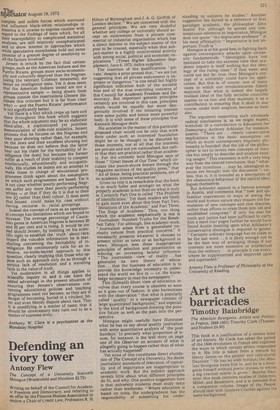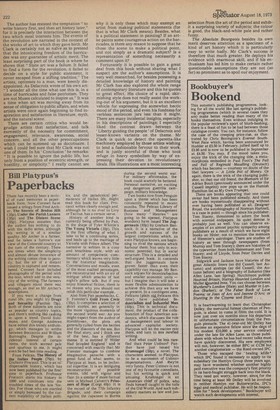Art at the barricades
Timothy Bainbridge
The Absolute Bourgeois: Artists and Politics in France, 1848-1851) Timothy Clark (Thames and Hudson £4.50) This book is a justification of a certain kind of art history. Mr Clark has taken the period of the 1848 revolution in France and explored the ways in which certain artists responded to it. His title is taken from a remark by Henry James on the painter and caricaturist Daumier: " He has no wide horizon; the absolute bourgeois hems him in, and he is a bourgeois himself without poetic ironies, to whom a big cracked mirror is given," Besides Daumier, this book contains studies of Delacroix. Millet, and Baudelaire, and it is intended that a companion volume. Image of the People, should deal with Gustave Courbet against the same background. The author has resisted the temptation " to write history first, and then art history later," for it is precisely the interaction between the two which most interests him. The events of the revolution are narrated in the context of the works of art to which they gave birth. Mr Clark is certainly not so naive as to pretend that the intoxicating freedom of the barricades was any guarantee of artistic merit. The least surprising part of the book is where he shows that "State art was a failure. It failed to find a form for the revolution, it failed to decide on a style for public statement, it never escaped from a stifling tradition." The artists, optimists to a man, were keenly disappointed. As Delacroix wrote of his own art: "I wonder all the time what use this is, in a time of barricades and false patriotism. They are not Muses calculated to inspire us." It was a time when art was moving away from its sense of obligation to public affairs, and when artists were once again beginning to find inspiration and satisfaction in literature, myth, and the natural scene.
There are certain critics who would begrudge artists that satisfaction, and talk earnestly of the necessity for commitment, engagement, relevance, awareness, social concern, and all the other preoccupations which can be summed up as doctrinaire, I wish I could feel sure that Mr Clark was not one of them. In his 'Conclusion 'he remarks: "It is possible to ignore the public life, but only from a position of eccentric strength, or hostility, or simplicity." I really cannot see
why it is only these which may exempt an artist from making political statements (for that is what Mr Clark means). Besides, what is a political statement in painting? If an artist paints some courageous action on the barricades, is there any reason to suppose that he chose the scene to make a political point, and not simply as a dramatic subject? Is a representation of something necessarily a comment upon it?
Fortunately it is possible to gain a great deal from this book without sharing what I suspect are the author's assumptions. It is very well researched, for besides possessing a detailed knowledge of history and painting Mr Clark has also explored the whole range of contemporary literature and this he quotes to great effect. His choice of a rapid, skirmishing style does not really assist the working-out of his argument, but it is an excellent vehicle for expressing the somewhat hectic mood of the period, and even his fondness for verbless sentences jars less than it might. There are many incidental insights, especially in his descriptions of paintings; I especially liked the contrast drawn between the 'Liberty guiding the people' of Delacroix and lesser-known variants on the theme. Mr Clark is quick to detect the operetta-like machinery employed by those artists wishing to lend a fashionable fervour to their work, and is justly scornful of those who took refuge in heavy symbolism by way of expressing their devotion to revolutionary ideals. His illustrations are a most interesting

































 Previous page
Previous page